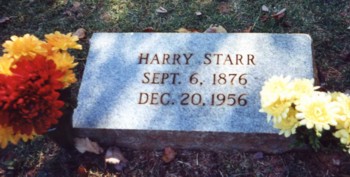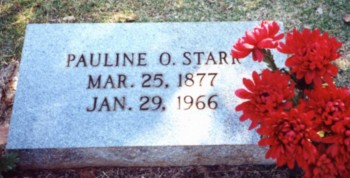Harry & Pauline
HARRY and PAULINE
Harry Starr (1876-1954)
and Pauline Olivia Rankin (1877-1966)
Copyright July 2012 by Linda Sparks Starr
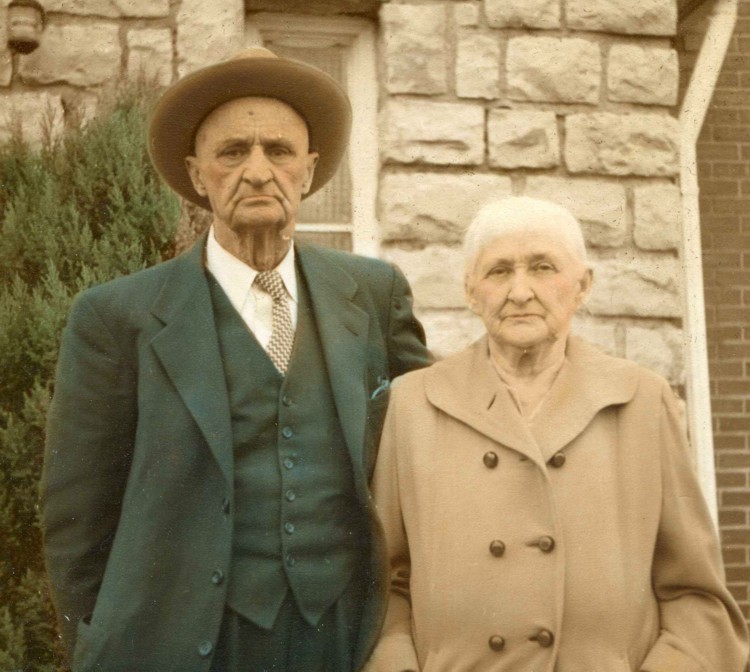
Harry and Pauline look somberly at the camera in this picture taken in the early 1950's in Kansas City. People born
in the Victorian era rarely smiled for photographs, they thought smiles would make them look foolish or unserious.
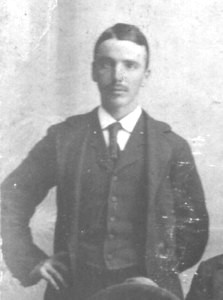
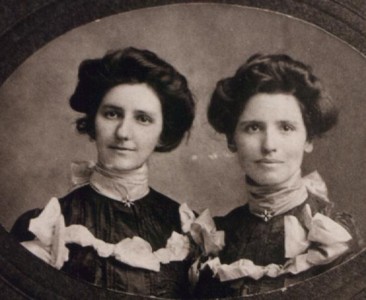 Although both grew up in middle class Georgia households, the early
years for Harry and Pauline couldn’t have been more diverse if
one designed them to be. Harry, reared by a single father, grew up in a
small rural Georgia community south of Atlanta. His father was a
medical doctor, but they likely lived on the profits from the small
general merchandise store he operated on the side. Understandably,
between two careers, Dr. John had little time for his growing son.
Harry’s Aunt Mary (Griffin) Tucker and her husband Thomas
welcomed Harry into their home at all hours of the day and night.
Although both grew up in middle class Georgia households, the early
years for Harry and Pauline couldn’t have been more diverse if
one designed them to be. Harry, reared by a single father, grew up in a
small rural Georgia community south of Atlanta. His father was a
medical doctor, but they likely lived on the profits from the small
general merchandise store he operated on the side. Understandably,
between two careers, Dr. John had little time for his growing son.
Harry’s Aunt Mary (Griffin) Tucker and her husband Thomas
welcomed Harry into their home at all hours of the day and night.
Harry
had fond memories of this extended family consisting of three children.
The oldest were twins Monnie and Marcia (names as they appear on the
back of
their photo); a boy, Dolphus, was born the same day Harry’s
parents were
married.
>>>>
Harry was nine years old when Dr. John married
the sixteen year old Katie Orr. Understandably the relationship
between Katie and Harry was strained from the very beginning. Harry had
an aptitude for math and one of the best math teachers in the
state taught in Calhoun, Georgia. Besides the opportunity for future
advancement for Harry, this also eased the tension in Dr.
John’s household. Until this time Harry’s known world
consisted of Sunnyside, possible trips to nearby Griffin, and visits to
his relatives living only a few miles away. No one dreamed the train to
Calhoun was also taking him to meet his future wife, Pauline Rankin.
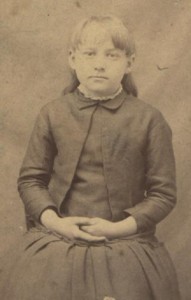 The bustling city of Calhoun was a far cry from little Sunnyside.
Located on the direct railroad route between Atlanta and Chattanooga,
it was competing successfully with other communities for new industries
along that corridor. Pauline’s father purchased the nearest
boarding house/hotel to the train depot, giving Pauline opportunity to
meet travelers from all over. The trains took members of the
Rankin family back to South Carolina for semi-regular visits with
relatives. Thus during her early years Pauline was exposed to a far
wider world than was Harry. Moreover, Pauline’s father was a
well-known and respected local and state politician and had diverse
business interests. Little happened that escaped discussion
around their dinner table.
The bustling city of Calhoun was a far cry from little Sunnyside.
Located on the direct railroad route between Atlanta and Chattanooga,
it was competing successfully with other communities for new industries
along that corridor. Pauline’s father purchased the nearest
boarding house/hotel to the train depot, giving Pauline opportunity to
meet travelers from all over. The trains took members of the
Rankin family back to South Carolina for semi-regular visits with
relatives. Thus during her early years Pauline was exposed to a far
wider world than was Harry. Moreover, Pauline’s father was a
well-known and respected local and state politician and had diverse
business interests. Little happened that escaped discussion
around their dinner table.
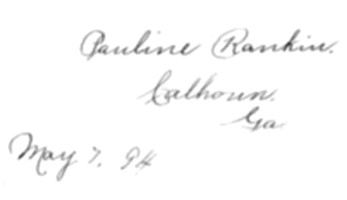 Pauline was one of seven children. All received the best
education their father
could afford. The girls were brought up to be
“southern ladies.” This encompassed the arts of playing
a musical instrument, singing, giving recitations and conversing
with gentlemen. There would be others to do the drudgery of house
cleaning and laundry.
Pauline was one of seven children. All received the best
education their father
could afford. The girls were brought up to be
“southern ladies.” This encompassed the arts of playing
a musical instrument, singing, giving recitations and conversing
with gentlemen. There would be others to do the drudgery of house
cleaning and laundry.
Although she attended private academies from time
to time, Pauline graduated from Calhoun High School. The list of honor
students for 1889 includes Pauline, her brother George, and friends
Eva, Cornelia and Dora Cantrell.
An example of her penmanship shows her fine, precise hand. The photo was taken in the 1880s.
Copies of pages in the family bible that documented Harry and Pauline's marriage and the births of the children may be seen here.
From here on, Harry and Pauline’s story is told by use of
extractions from Harry’s pension application and interviews over
the course of several years with three of their children, a son-in-law
and narratives written by two grandsons and one granddaughter. The key to narrator:
ALICE (Starr) Schisler
GLADYS (Starr) Campbell
JACK – Jack Starr
JS – (son-in-law) Jack Schisler
JERRY – Gerald “Jerry” Starr, son
of Jack
DAVID – David Starr, son of Jack –
from English assignment dated 1955.
JEAN – (Starr) Whipple, September 2000,
daughter of Jack
Readers may note some minor discrepancies between the various accounts.
Some factual errors may be observed (e.g., that Harry "went around the
world" while in the military is an exaggeration--he traveled from New
York to the Phillipines).
That is to be expected in memories stretching back many decades. Here
there has been no attempt to fact-check their stories, but rather to
let them speak in their own words.
JACK: Harry, born 6 September 1876 in Sunnyside, Georgia, was the
only child of Dr. John Pinkston Starr and his first wife. Harry
was only eighteen months old when his mother died; he was “mostly
raised” by his maternal aunt. Harry and his cousin [Dolphus
Griffin; see picture above] got into the usual boy-mischief troubles together.
One
of their more serious offenses was swiping chloroform from Dr.
John’s medicine bag. They enticed another boy to sniff this
substance which rendered him unconscious. Even though the boy
recovered, they regretted this prank later when they understood the
possible consequences. Harry was nine years old when his father
married a sixteen-year old. Perhaps the closeness of their ages is one
of the reasons they never really got along. Harry received his
elementary education in Sunnyside. He showed a great aptitude for
mathematics so was sent to a school in Calhoun known for its excellent
math teacher. This teacher prepared Harry for jobs he held
throughout his adult life. It was while attending this school in
Calhoun that he met Pauline.
After graduating from the school in Calhoun, Harry went to Dallas,
Texas and worked in a dairy for some time. The Spanish-American War
started while he was in Dallas and he enlisted in the Army and served
in the Hospital Corps. He was first sent to Brooklyn, New
York to serve for six months in the Navy yard. It was while he was
in Brooklyn that his great love of the game of baseball grew. His ship
went to Havana, Cuba, and eventually circled the world. The Corps
went to the Philippines to get some critically ill soldiers to take to
San Francisco. His last assignment was to accompany a terminally ill
soldier back to Alabama. The soldier’s parents were waiting at
the railroad station to receive their son. Harry said one of the
saddest things he ever had to do was help lift this soldier and lay him
in the back of his parent’s wagon. He never saw the soldier
again. In later years Harry stated he was perhaps the only
soldier of the U.S. Volunteers to serve in both Cuba and the
Philippines without re-enlistment. Some souvenir pictures from his time in Cuba can be seen here.
HARRY (age 47 supplemental affidavit for Pension dated 23 October 1923):
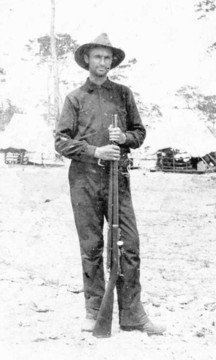
“I enlisted at Austin Texas
on May 4th, 1898 in Co K of the
2nd Texas Vol. Inf. We
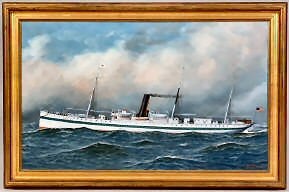
were moved from there to Mobile Alabama thence
to Miami Fla. There in the month of July I was transferred to the
Hospital Corps. We were moved to Jacksonville Fla. and thence to
Savannah Ga. Here I was detached with two others for service in
Hospital Corps with Signal Corps. In December 1898 we were taken to
Havana Cuba and remained there until about May 1st, 1899. Then I was
transferred at my own request to the Hospital Ship Missouri. [Note: The
Missouri (the subject of the painting at right), one of America's
earliest hospital vessels, saw heroic service even before the war with
Spain. For an interesting account, go to
this
site. The
Missouri's
dramatic rescue in 1889 (before it became an American vessel) of the singking
Danmark's passengers is
depicted
here.] After
making a trip to Newport News, we went to Brooklyn N.Y. for repairs and
on Oct 16, 1899 we started to Manila P. I. and landed there about Dec
1st 1899. We left Manila P.I. about Jan 1st, 1900, and arrived in
San Francisco Calif in Feb 1900 where I remained on Duty until I was
discharged on May 4th 1900. I was given an honorable discharge by Major
A. C. Gerrard.” [file #1,490,903 Veterans
Administration]
Harry at camp in Florida >>>>>
The Early Years Together
JACK: After his discharge and return to Georgia, Harry continued on to
Calhoun where he and Pauline were married. They had dated
for a long time, but had never set a date for their marriage.
According to Papa who “loved to tease and joke and told this with
a mischievous grin,” when he returned after his service, she told
him they either set the date or forget about it. They were married
Wednesday evening, November 21 at 3:30 p.m. in her parent’s
home by a Presbyterian minister. She was twenty-three and Harry
twenty-four.
Their first home was in Sunnyside where Harry managed his
father’s grocery store for the next few years. They lived in a
house not far from his father and step-mother. Four children were born
here, all delivered by their grandfather, Dr. John P. Starr. All were
baptized in the same church Harry had been baptized in. It was also the
same church where Dr. John had married Harry’s mother; but, it
was called Shiloh Methodist then. Their relationship with step-mother
Kate was not a good one and they wanted a different life.
Baby Alice
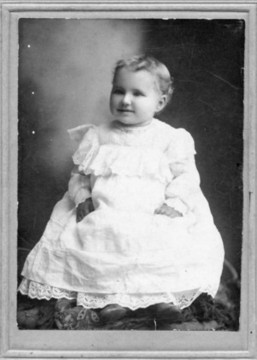
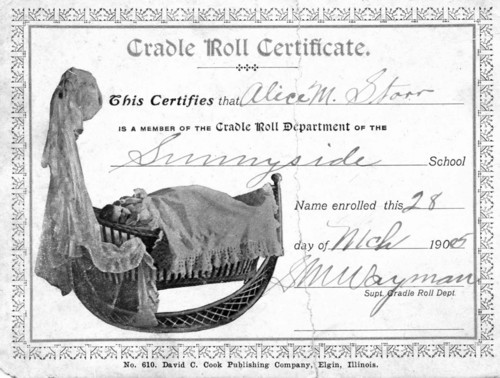
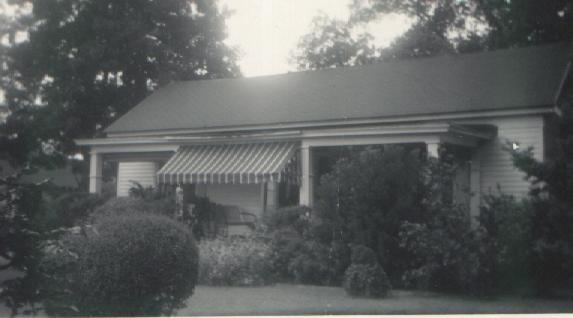
The house where Alice--and presumably William, Harry and Estelle--were born.
ALICE: Papa and my Grandpa had a store in Sunnyside and
they decided they didn’t want to run the store together
anymore. Papa wanted to make a change and they moved up to
Calhoun. Uncle King
[Norton] was a salesman; they were called a drummer
at that time. He had a good job and he wanted Papa to do that
too. He got Papa a job, but Papa had to be gone from home so much. Mama
had four little children – I was only four and a-half -- so
she said he ought to be home to help her instead. Uncle George
[Rankin] – Mama’s brother – wanted Papa to come
West.
At that time people were coming West to seek their fortune. It seemed
everybody who came West got rich. Some people made money on cattle and
lumber. Papa decided to come West to get his fortune and we came.
JACK: Pauline’s brother, George, had moved to Arkansas
earlier and it was decided to join him. They traveled by train to
Arkansas, but Harry always said he walked the entire way. Their
youngest child, Pauline Estelle, was ill when they left Georgia and
Harry carried her in his arms while walking back and forth the length
of the train.
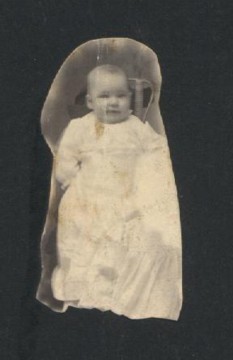
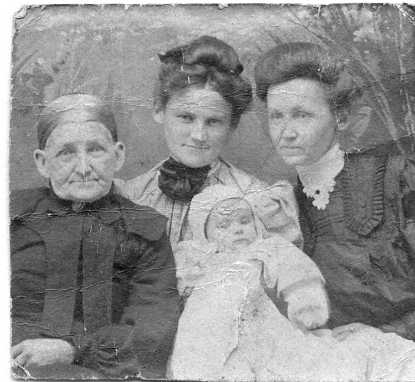
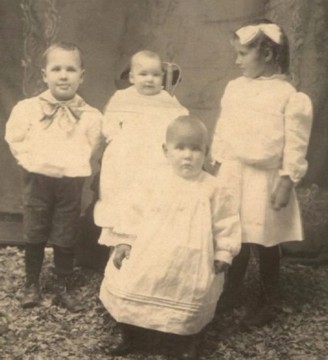
Pauline Estelle
Estelle next to Margaret (Ramsay) Rankin
1906:
William, Estelle, Harry, Alice
ALICE: We left Calhoun, the first time, in the spring of 1906. We came
to Arkansas first, lived at Cove a little while. We lost our little
sister to an infected spider bite when we first moved to a saw mill
set. [Pauline Estelle Starr died 20 September 1906
near Cove, Arkansas, 11 months, 9 days old. Buried in unmarked
grave in Cove Cemetery.]
JACK: They moved from Cove into Oklahoma which was then Indian
Territory. ALICE: They sent him out to the
sawmill – sets they called them. We lived in several places
because they had to move the sets to where the timber was.
Papa had charge of hauling logs. He drove teams of mules and some
oxen. He had helpers. He used oxen because they could get through
the mud better than horses. DAVID: He did logging and sawmill
work where they were paid by a grocery order, beans and salt-pork with
a little flour, those being the staples for each week.
HARRY: (Letter to Helen dated November 20th, 1929 – ink
blotched): “Twenty years ago this date I was driving four
oxen and hauling a load of ____ver, that is not the only thing that
happened that day. We were all petting and smiling at a little baby
girl that we decided was as pretty as Helen of Troy. ... We are still
just doing ... as well as usual ... We are raising two or three
chickens for the time [you will come home] and it will be the old tune
of ‘kill a chicken and churn.’ ...
GLADYS: During her childhood and while living in Sunnyside after
her marriage, a black laundress took care of all the laundry chores for
Pauline’s family. Until the move west, she had given little
thought as to what was involved. Once they moved, it was necessary she
do it all. She observed that a huge pot was filled with water and then
a wood fire was built around it. Finally, one combined hot water
and soap, then scrubbed the clothes in the pot on a scrub board.
So she set herself to the task. During that first attempt, she was
horrified at the sight of a grayish scum forming in the water as it
heated. She tried skimming, but more scum formed. She just
sat down and cried. Another lady in the camp saw her crying and
came over. The lady 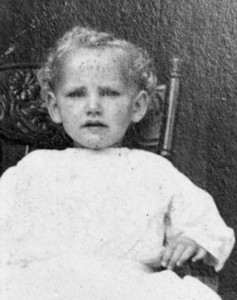 was amazed that Pauline did not know to
“break” the water by adding a little lye. Pauline was
even more amazed when the lady offered to do the laundry for her. This
gesture shocked her. She had never heard of white folks hiring out to
do laundry. But she was delighted and Pauline became the first woman in
the camp to hire a laundress. I heard Mom tell this story many
times.
was amazed that Pauline did not know to
“break” the water by adding a little lye. Pauline was
even more amazed when the lady offered to do the laundry for her. This
gesture shocked her. She had never heard of white folks hiring out to
do laundry. But she was delighted and Pauline became the first woman in
the camp to hire a laundress. I heard Mom tell this story many
times.
The logging camps were located in densely wooded areas and there were
many wild animals – deer, bobcat, snakes, panthers, etc. –
around. On the first night after one of these moves, they had
gone to bed and the only noises were those of owls and distant night
birds. The baby (Helen, then about one year old) slept between my
parents. During the night my father awakened; his hand was
grasping a smooth, sleek, round object. He was almost petrified with
fear, but managed to awaken my mother and told her to gently get out of
bed and take the baby – that there was a snake in the bed with
them! Her exit was one of haste, as she quickly grabbed the
baby. Poor Helen: her arm was almost torn from the socket
for my father’s grasp around “the snake” was quite
firm.
JACK: Life was very hard and Pauline longed to return to Georgia.
Her father sent money for her and the children to come home for a
visit. Before she left, she and Harry decided to return to Georgia; he
promised to follow as soon as he could.
ALICE:
Mama, William, Harry [Jr.] and I went back to Calhoun and stayed five
months. Papa had the stock and he couldn’t get the price he
wanted. Things got a little better and we came
back.
Helen as a
baby..
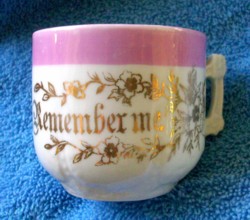 JACK: Papa never managed to accumulate enough money to move back
to Georgia and was too proud to ask either parent for help. Besides, he
liked Oklahoma and really didn’t want to return to Georgia.
Pauline was unhappy being away from him and after several months, she
asked her father for the money for the return trip to Oklahoma. She
returned to Georgia only twice more during her life and those trips
were made many years later.
JACK: Papa never managed to accumulate enough money to move back
to Georgia and was too proud to ask either parent for help. Besides, he
liked Oklahoma and really didn’t want to return to Georgia.
Pauline was unhappy being away from him and after several months, she
asked her father for the money for the return trip to Oklahoma. She
returned to Georgia only twice more during her life and those trips
were made many years later.
Cup given to Alice by her grandfather, W.R. Rankin, just before she
left to return to Oklahoma. >>
JERRY: Were the Rankins unhappy about the move out to
Oklahoma? ALICE: Unhappy! They thought we were
going out of the world, that is was wild and woolly out here. When we
left, the Snake [Shoshone] Indians were fighting among themselves and
Mama was scared to death. She kept William, Harry and me right around
her all the time. One day Papa told Simon Bear, one of the
Indians, that “my wife’s afraid of Indians.” Oh
says he: “We’re not going to hurt you white
people.”
GLADYS: This area was heavily timbered, and although there were
many logging camps, there were no schools. My father had 3 school age
children and it disturbed him that there were no learning facilities
for them and the other children in the camps. So he decided to
take a giant step and open a school. He had had two years of college
training and he felt capable of teaching the basic three
“Rs” - reading, ‘riting and
‘rithmatic. [He received a temporary teacher's certificate in
1911.] Word was passed and school opened in the
one church that served the area. The building has been maintained
and still stands [1986] near Watson, Oklahoma. Imagine his amazement
when 90 children showed up for school! They ranged in age from 6
to 16 and only one of the entire group had had any previous schooling.
The 15 year old, Lee Blake, was at the 5th grade level. He became my
father’s assistant and school was in session for two hours each
day. Harry received a [regular] teacher’s certificate several
years later
and taught in a settlement known as Nuna Chito, an Indian name for
“Big Hill.”
(In 1911 Harry was one of five trustees of the Sulphur Springs
Methodist Episcopal Church, South, located at Watson, Oklahoma.
On March 1, L. L. Nichols and Ida Nichols sold a plot of
land for $1 to be used for the church. The other trustees
were: E. E. Collins, J. H. Baucum, Josiah Helton and J. H.
Smithton.) The church is pictured below.
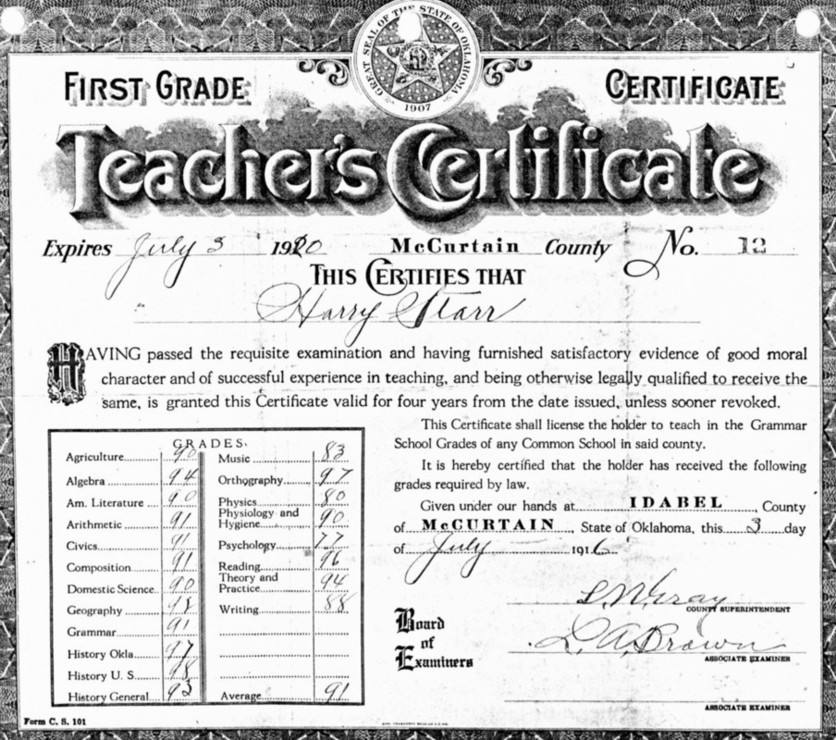
DAVID: Some of his favorite stories are
about the schools in
southeastern OK. On the first day, he found himself the teacher with a
room full of one hundred children, seventy who could not speak a word
of English. His knowledge of the Indian language was sometimes
not enough, but this did not stump him. He just used
a little Spanish
that he learned while in Cuba.
JACK: Pauline and Harry lived in numerous communities. They moved
to Watson, Oklahoma from Cove, Arkansas and farmed there. A
school was formed, but it needed a teacher. Harry was the only one
around qualified to teach, so he traveled to Idabel, the county seat
for McCurtain County, to take a seminar to help him qualify.
He started
his teaching career at Watson. In his first school there was 105
students. Sixty-five of them were Choctaw Indians and couldn’t
speak English. Harry had learned the Choctaw language so was able
to converse with them. The first textbooks were mail-order catalogs.
He
continued farming as well as teaching. He raised the best cotton he had
ever raised in 1913. The price, however, dropped to five cents a
pound so he left it in the field and vowed he would never plant cotton
again.
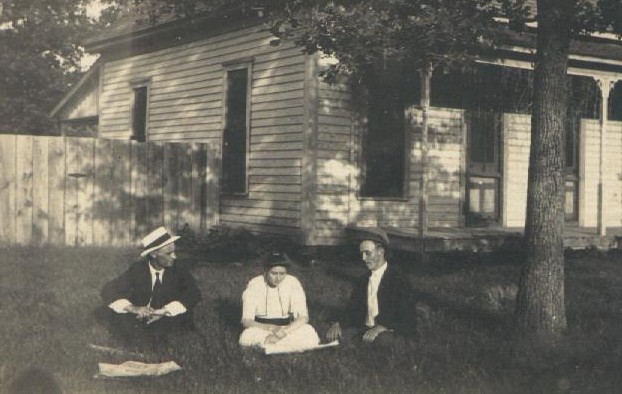
Harry, at left, in Idabel. Woman may be Pauline, but picture only identified Harry.
That was in the early days of Oklahoma right after statehood. I
didn’t start to school until about 1920 whereas Papa taught
school shortly after statehood. I don’t know just what year it
was, but I do know he was teaching at Watson about the time I was born,
1913.There were a lot of whites in there then, but of course, there
were a lot of Indians because it had been the Choctaw Indian Nation.
This is the school where they used the catalogs for books at first.
That was timber country then and there were lots of saw mills,
independent little sawmills around, which hired quite a few people. Of
course, those people had lots of children. And they moved those saw
mills a lot and the people came and went.
Catalogs accumulated in the Post Office because people didn’t
pick them up and they weren’t returned in those days. They
accumulated a whole stack of Montgomery Ward and Sears Roebuck catalogs
in a back corner. They took the catalogs to the school and used them
until they could get some books. I understand they used those catalogs
for most of that first year. It was a pretty good idea because the
reading in the catalog was related to the picture.
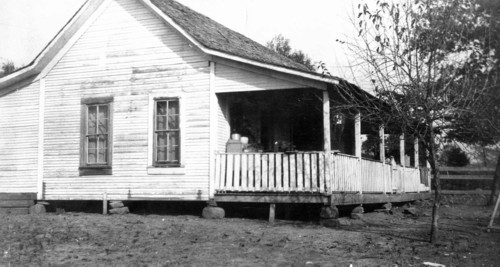
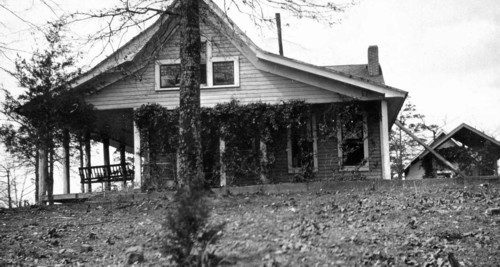
Two rental houses in which Harry, Pauline and the children lived before the move to Smithville.
When they wanted a teacher they didn’t have anyone to teach. My
Dad became the teacher as he was about as qualified as anyone could be.
He had, I guess you might say, finished high school. I’m not sure
he had, but he went to school in Calhoun to become a mathematician.
They got him to go down to Idabel to take a seminar like thing and he
got a teaching certificate. When he came back he became the teacher. He
taught for a number of years after that. After we moved to
Smithville, he taught school at Octavia and had to walk about five
miles to the school. I remember one morning there was snow on the
ground and he got up and wrapped his feet with tow sacks and tied them
on with strings so his feet wouldn’t freeze while he walked the
five miles to school.
The Smithville Years
ALICE: We moved to Smithville in 1916. At the time it had four
general stores, a post office and a bank was there for a while.
When we moved there, Papa was the postmaster. And then he taught
school. He quit the sawmill business. He started teaching and did a
little farming. We always had a crop ... had a cow for our own
milk and butter and chickens. JS: They had a very
good garden. Must have had a half-acre in that garden.
ALICE: More I’d guess.

The Smithville house.
DAVID: They purchased the large nine room white house overlooking
the valley [near Smithville] for one thousand dollars. Harry was very
proud of his church, a small wood building that was donated to the town
by Folsom Training School. Countless times as we topped the last
hill before coming into town, he pointed with pride to the
glistening tall steeple and said “There is one of the most
beautiful and inspirational sights you will ever see.”
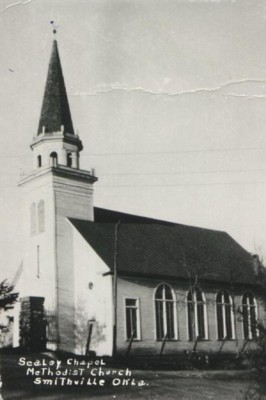
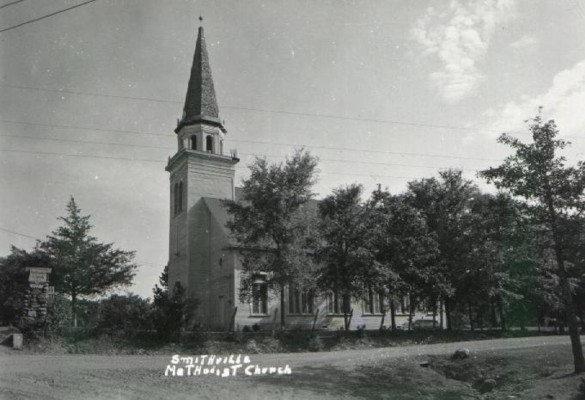
Two views of the structure that served Folsom Training Institute as a
chapel, and later as Smithville's Methodist church. It no longer stands.
JACK: When I was a small child Smithville was quite a little
village. There were stores for over a block on each side of the road
and some were pretty good sized stores. The Lebold Lumber Company was
operating there then. They had a sidewalk boardwalk all the way
up. It was quite a town. I can remember one time when I was
a little bitty kid we were downtown. Some guy had gotten drunk, got on
a horse and got up on that boardwalk. He was riding the horse up and
down on that boardwalk. It made a terrible noise and everybody was
excited. We didn’t have any saloons in the town, but there
was plenty of whiskey around. Back in the 20s that was one of the main
whiskey making areas of the state. The area around Hochatown became
quite famous. They called it Hochatown Hooch. It was back in the
mountains to the south between Smithville and Broken Bow. In fact,
Hochatown was covered up by the Broken Bow Reservoir. They had to
move the town, but I don’t think there was much of a town to
move. There were lots of canyons and rough country. They made
lots of whiskey in there and trucked it out across the state during
prohibition days. That was a big deal.
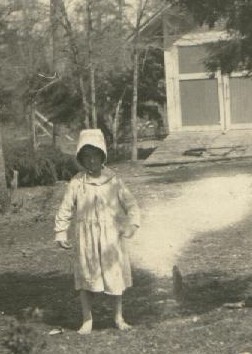
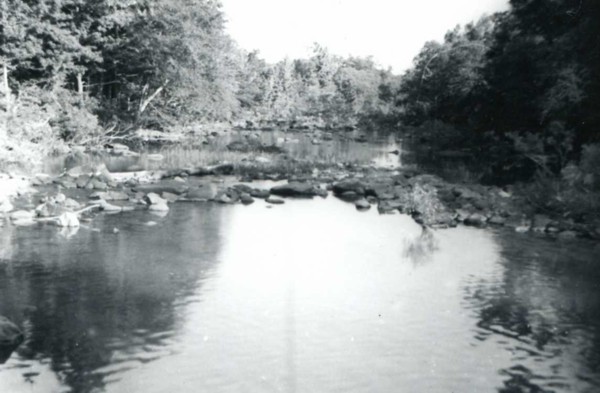
Gladys at about age
five.
Mountain Fork river near Smithville.
JS: We enjoyed Smithville when we moved there. I had never lived
in a country where there was pine trees and real running water like
that. I thought that was one of the most ideal places in the world when
I moved out there. I loved to flyfish and if I fished more than 30
yards up the stream and didn’t catch enough fish, the fish were
not biting.

This picture of Smithville appears to have been taken about 1937.
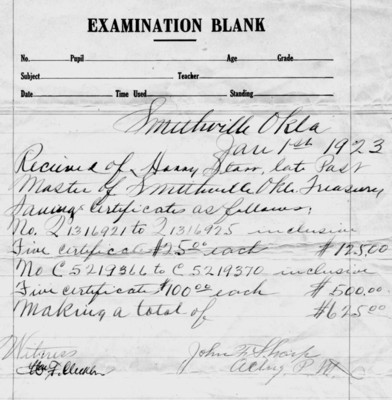 JACK: Democrat Woodrow Wilson was President when the family moved
to Smithville. Harry, a Democrat, was appointed Postmaster in 1916. He
ran a store in conjunction with the post office. With the election
of a Republican President in 1920, Harry lost his job as
postmaster. He then worked as an estimator and buyer of timber
for the Cove Lumber Company. In later years he did the same work
for the Three States Lumber Company. In 1929 he began working for
himself, surveying, estimating and purchasing timber. Harry loved
the outdoors and had a special love for trees.
JACK: Democrat Woodrow Wilson was President when the family moved
to Smithville. Harry, a Democrat, was appointed Postmaster in 1916. He
ran a store in conjunction with the post office. With the election
of a Republican President in 1920, Harry lost his job as
postmaster. He then worked as an estimator and buyer of timber
for the Cove Lumber Company. In later years he did the same work
for the Three States Lumber Company. In 1929 he began working for
himself, surveying, estimating and purchasing timber. Harry loved
the outdoors and had a special love for trees.
HARRY: The funniest thing that ever happened to me. After working
for two hours on the books of the Post Master, a friend of mine
suggested that we take a snort. I readily
acquiesced. After we sampled the moonshine, we took a real
good drink. After going back to work my friend discovered that
his eyesight was not normal. I also found that my vision was not clear.
ALICE: Papa first worked for Blake Barkley. He’s the one
who wrote to Papa and told him to come, that he’d have a job when
he got there and he worked for him. Barkley sold out to
Dierks. Dierks first went to Arkansas then to Broken Bow.
JACK: My Dad worked for the Cove Lumber Company during the 20s. I
believe it was 1928 that the Cove Company sold out to Dierks Lumber
Company. They did that just before the depression. My Dad often said
that was the smartest move the Barton boys or Blake Barton who owned
the Cove Lumber Company, made. He sold out just before the depression.
He got his money from Dierks, went out west to Oregon which was new
country then, bought out there and made a lot of money later.
It was around 1928 before Papa had to work on his own. We made trips to
the courthouse in Idabel to handle some of the business transactions.
We hardly ever went to Mena, or anywhere, while I was growing up.
JERRY: Going to Idabel was an all day trip. JACK:
Yeah. We’d get up real early in the morning. Papa had a Star car
... we’d get in that car, an old touring car was about the only
kind of cars there were in those days. All with curtains on the
sides. They didn’t have any glass. The road from
Broken Bow to Idabel was a pretty good gravel road. In this day and
time it wouldn’t be called a very good road, but in those days,
it was considered a good road. From Broken Bow to Bethel was a
so-called highway. It had been graveled, but it wasn’t kept up
too good. It was passable; I mean you could get over it.
From Bethel to Smithville was another 18 miles. It wasn’t even a
graded road. Wagons and cars had made ruts forming a sort of trail
which you’d follow. There were a lot of places where you had to
drive real slow because it had washed out, had high centers and things,
or mud holes where you’d get stuck if you didn’t watch out.
And sometimes you would get stuck and would have to fool around and get
yourself out by getting some poles or something to put down so you
could get out of the mud hole.
We’d get up real early in the morning and start out about
daylight and we’d get back way in the night usually. All
we’d do is go down there; however, it was 55 miles down there and
55 miles back. In those days, 110 miles was quite a trip. That was a
long, lonesome road. You hardly ever met anybody on that trip,
especially after you got back past Broken Bow a ways. You pretty well
got out of civilization from there and I don’t remember ever
passing anybody. People weren’t going that fast. You went
over Carter Mountain about halfway between Broken Bow and Bethel. It
had a hairpin bend. You went up this canyon a long ways and then you
cut right back over yourself to go back up the mountain. Finally you
topped out the mountain over there and went down a long ridge going
down towards Broken Bow. Right now that’s in the area of the
Broken Bow Reservoir.
HARRY: (Letter dated March 27, 1925 in reply to his Uncle J. W.
Starr in Atlanta who was then working on a family history.)
“...There is another little item that I will call your attention
to with a little pride. Alice, William, Harry and Helen are members of
the M. E. Church South. You will notice in the Church papers that the
Church has an institution here called Fulsom Training School. I am
educating my children in it. William graduates this year, Alice, next
year and Helen the next. Harry is up at Bristow working for the Okla.
Pipe Line Co. He joined the Church this year. He got angry with the
faculty here and quit school. He is doing well and is well thought of
every where. ... I am working at the same job, timber buyer for
the Cove Lumber Co. I have not heard from the last letter that I wrote
you in regard to timber. We had a big deal last fall just west of us.
The Dierks people paid $224,000.00 for 24,000 acres. Timber is higher
here than in Ga. I hope to have a fine business this year and am
making a good start.”
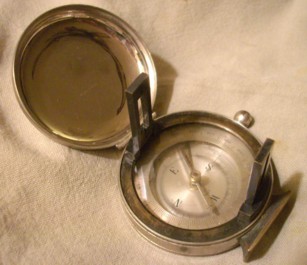 JS: I worked with your Granddad in the woods when he was cruising
[surveying and estimating] timber for Shaw. Then he switched over to
Dierks. A lot of times he cruised the same pieces of timber. At first
he cruised for Shaw and then Dierks would buy it and he’d have to
go over the same thing. Well, he already knew what was there.
I've seen trees too close together and that big around you
couldn’t drive a car between them in the thicket, I mean,
millions and millions of board feet. I had a big time working with him.
He'd tell me about things that had happened.
JS: I worked with your Granddad in the woods when he was cruising
[surveying and estimating] timber for Shaw. Then he switched over to
Dierks. A lot of times he cruised the same pieces of timber. At first
he cruised for Shaw and then Dierks would buy it and he’d have to
go over the same thing. Well, he already knew what was there.
I've seen trees too close together and that big around you
couldn’t drive a car between them in the thicket, I mean,
millions and millions of board feet. I had a big time working with him.
He'd tell me about things that had happened.
He had a great big old compass, one that he got from the government
I
guess. He knew where every section line corner was at that end of
the county and he knew where everyone of them was, so far as I know. He
knew where the forty was and where the section line corner and
we’d start there. In those days if you looked real carefully you
could see where the old blaze mark the government surveyor had made on
the side of the tree – all grown over, but you could see them.
He’d say: “Now Jack, you take this corner –
keep to the section line to the corner plate and you follow on down to
the next corner or forty acres, and I’ll get on the inside about
25 to 30 yards and we’ll go around this forty.” And
when we got back, he had a record of about not more than five percent
error in estimating the amount of board feet on that place. I
don’t know what kind of formula he
used.
Harry's compass >>
I’ve told this story to Alice several times. We’d been out
all week – he camped out at night and we did our own cooking and
everything ... we’d go out Monday and be back on Friday. I
noticed he’d usually pull off a piece of something or other, a
pine or some little twig and chew on that twig. One day I noticed
him a talking to himself and a talking to himself. I said:
“Starr, there’s something intriguing me.” And
he said “What’s that?” I said:
“What in the world are you talking to yourself about so
much?” And he says: “By gum, I like to hear a
smart man talk.”
JACK: When Papa was working in the woods he was gone most of the day
and a lot of time, he didn’t have much of a dinner. Sometimes,
when I worked with him, we’d carry our dinner -- a few crackers
and a can of potted meat or pork-n-beans to eat at noon. We’d
just drink out of the creek for our water. There was always a
creek or stream of clear water nearby. I guess it was alright, because
it never hurt us. The streams in the mountains run through shoals
and rocks which I guess purifies the water if it is polluted.
In 1933 we were hunting timber and the next day after we were in there,
some deer hunters with some dogs found a guy dead in a thicket in
there. I don’t know how close we walked to him, but we walked all
over it. In estimating timber you have to see all the trees. I was
running the lines and Papa was working with me. I probably didn’t
get very close to him, but Papa might have gotten close. Of course, he
was looking at trees and not at something on the ground, so he might
have been pretty close and still not seen him. Anyhow, the man had been
there quite a while.
HARRY: (Letter to Veterans Bureau May 15th 1933): “I
served in this company until July 1898 and was found upon medical
examination to have become unable to serve farther in the infantry, and
for this reason, was transferred to the hospital corps. The above
happened at Miami, Florida. The disability occurred on account of
excessive drilling and was in line of duty. The disability was the same
as I now have and am drawing a pension for ... I wish to farther state
that at the time I was discharged from the service .... I was not
examined and no effort was made to ascertain my physical condition. ...
I farther wish to state that I am dependant upon this money to sustain
a wife and family of three children. I have no job and am unable to
perform a hard day’s labor.”
Childhood Memories
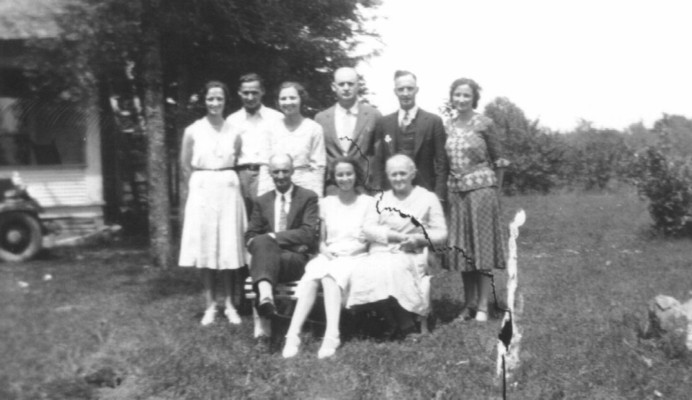
1931: L to R, Gladys, Jack, Helen, Harry, Willliam, Alice,
Seated: Harry, Ione, Pauline
JACK: Each of us kids was assigned a job. Mine was to get in the wood
and get up and build a fire in the morning. And on the days we washed,
I drew water out of the well, filled the wash pot and built a fire
around it. And then I drew water to fill the tubs for
washing. In the winter the house was cold, of course.
I slept upstairs and by the time I got down to where the stove was, I
was already cold. The first thing I did was to build a fire in the
heater in the living room. I’d put some paper in there and then
I’d put in some kindling. We’d chop up pine which makes a
kind of kindling that ignites pretty well. Pine is usually full of
pitch and it’ll burn almost like kerosene. I’d
then put a pine knot on the top of it and some more wood. Then
I’d pour a little kerosene in the bowels of the stove and throw a
match in there. It’d take off with a sound like a freight train,
and sometimes it’d get red hot clear up past the elbow.
It’s a wonder I didn’t burn the house down. But anyway,
you’d get warm in a hurry.
I’d warm myself, then go into the kitchen where the cookstove
was. Building a fire in the cook stove was a slower process. Too much
pine wood or fast burning wood causes poor cooking conditions. If you
got it too hot, then it’d cool off. We’d have split [slower
burning] wood for the cook stove. By the time I got it started,
the girls would be up. Helen was the one who cooked the breakfast then.
She’d come down and make biscuits, cook the bacon, make the gravy
and fry the eggs and stuff. That was the way it went when I was growing
up for over a period of several years. We had biscuits every
morning I guess. I don’t ever remember us not having hot biscuits
and butter. We had a cow we milked that furnished us with all the
butter and milk we wanted. I guess we had what you would call
buttermilk biscuits. Helen would usually make those biscuits and
she’d mix everything in but the liquid the night before. Like me
building the fire, she had it down to a science and she could make
those biscuits pretty fast. We always had a big breakfast.
I think that was due to my Dad. That was one of our main meals.
And we had things for breakfast a lot of people don’t have today,
like macaroni and cheese. That was one of our favorites and we liked it
for breakfast. Another thing we had was brains and eggs.
Every time we butchered, which we did occasionally, the first thing
we’d have was fresh brains and eggs for breakfast the next
morning.
JERRY: Dad says one of his chores was to get up early and get the
fire going on the stove. ALICE: That’s right.
The boys did that and the girls got up and cooked
breakfast. We had sausage and steak and ham and scrambled
eggs and hot biscuits and usually preserves and jelly.
Jerry: Where did the macaroni and cheese come in? ALICE: Sometimes
we’d have that too. Because when we’d have it and everybody
wasn’t up, Papa’d say “Come alive, macaroni and
cheese.” We all liked it and Mama could make it so
good. I’ve never eaten it anywhere that made it like Mama
did.
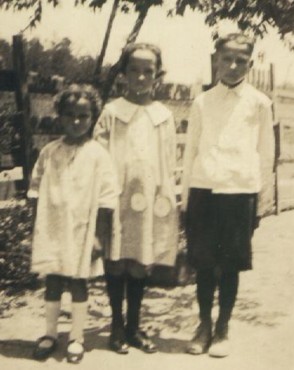
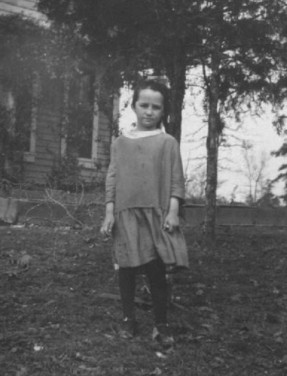
L to R: Ione, Gladys and Jack
Gladys
GLADYS: Breakfast at our house was a major meal and it was
usually prepared by the oldest girl at home. My father always built the
fire in the wood stove and put the kettle on. I was 12 or 13 when I
became chief breakfast chef. My two older sisters had gone away to
college and it was now my turn – but one I had not really longed
for. On winter days the cook stove had not heated the room to the
point of coziness and many times I would wait for the second or third
call before rising. Usually I set the table at night. The plates were
placed at the back of the stove to warm as the food was cooked. Besides
biscuits, there was oatmeal or cream of wheat, bacon or sausage, eggs
and of course, jelly and home made butter and coffee. After the
meal, there was clearing the table and doing the dishes. We had two
dishpans for this chore – one for washing and one for rinsing. I
washed and Ione dried. When this was done, the floor was swept and
mopped and my mother took over for preparation of the noon meal –
another hearty affair. Supper was usually leftovers from noon.
In the summer we always had watermelon in the afternoon, but always by
4 p.m. Partaking of the juicy melon later might induce
bed-wetting – the bane of my mother’s life. Each of
us made our own bed and, of course, dishes had to be done after each
meal. Two other chores stand out vividly in my memory. Sometime during
the day it was my task to clean and fill the kerosene lamps – a
job I loathed. We had eight lamps and the chimneys had to be washed and
wiped, the bowls filled with the oil, and the wicks trimmed. The
inventor of the incandescent bulb will always be, to me, one of the
heroes of all time. I always emerged from this chore reeking of
the smell of kerosene. The other distasteful task was emptying
the chamber pots – a job I assumed at about age 9. There were
three – one for Jack, one for my parents, and the one shared by
all the girls. After emptying them, they had to be scalded and
set in a sunny place to air until bedtime when they were brought in
again. Nocturnal noises I so well remember are the ringing of a cowbell
in the lane, the screech of an owl in the grove and the clang of the
lid on the chamber pot.
JACK: Life in summer sort of revolved around water. We
didn’t have running water at home; we had to draw it out of
wells. We went to the creek to take our baths. When I was a small
boy, we went swimming about everyday in the summer and we learned to
swim. We had a hole of water down on Rock Creek which was about a
quarter of a mile from our house. We’d go down there about every
day and swim and play. There was a big tree down there. The roots had
washed out from under it and it fell into the creek parallel to the
bank except it was in the water. The water was fairly deep there, about
5 or 6 feet. We’d got us a board and worked it around somehow
until we had a diving board there like the big city people had.

The Mountain Fork river was farther from the house, but afforded more
space to swim.
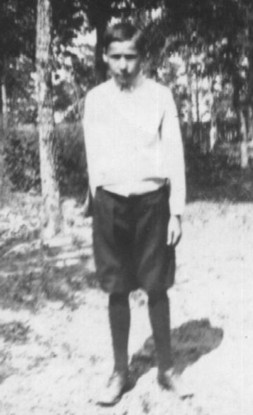
JERRY: A lady at work was
remembering the hand dug well of her
childhood; she mentioned frogs. JACK: In the
early days, before we had a wood curb on the well, it was impossible to
keep frogs out. It’s a kind of a wood box around the well.
You’d get some frogs in there in spite of an anything you’d
do, especially in the dry periods of the summer when there wasn’t
any water anywhere else. You could see them down there, swimming
around. You could usually get them out by just letting the bucket down
and holding it over near the frog. It’d go into the bucket and
you could pull it out. But about once a year we’d clean out
the well because there was always dirt and stuff that would fall off
the side of the dug well. It was my job to go down in there. I’d
sit on the bucket and they’d let me down into the well which was
about 30 feet deep.
Jack, ca. 1926 >>>
We’d first draw all the water out we
could. We did this in the summer when the water level was pretty low
anyway. There was always water in there, but sometimes it would
be pretty slow in coming in. There was a water vein down there in the
rocks. We’d save some of the water that we drew out.
I’d take some implement and a broom with me to clean the dirt out
of the crevices in the rocks. The rocks were creviced from the blasts
of dynamite used when digging the well. I’d clean them the best I
could. They’d send down buckets of the saved water and I’d
throw it on the crevices and scrub and slosh it around, rinse it out
and when I got through, it was really clean. Then I’d get on my
bucket and they’d pull me back out. Afterwards, the water
would come back in. It does sound unsanitary, but that’s the kind
of thing you have to put up with when you have a dug well.
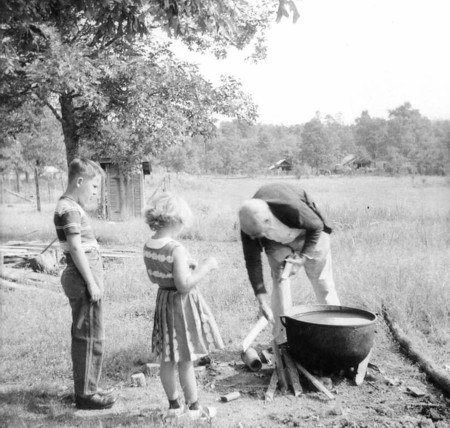
Grandchildren Gerald and Kathryn Jean Starr watch as Harry demonstrates
building a fire under the old wash pot. Note old outhouse in back. ca.
1951
GLADYS: Monday was washday if it was not raining. Jack drew the
water from the well and filled the tubs and wash pot. Then he
built a fire around the pot. By 7 a.m. Mrs. Mowdy arrived. The clothes
were scrubbed on a rub-board, then put into the pot of boiling sudsy
water. After a period of boiling, they were lifted out with the
punching stick and put into the first rinse. There they were swished
and wrung by hand and then placed into the second rinse. The bluing
rinse followed. Starch was cooked inside on the cook stove and
items that required starching went through this procedure before being
hung on the lines to dry. Shirt collars and fronts took heavy starch
and pillow cases, napkins, dresses, khaki pants, and dressier scarves
took a lighter starch. Mrs. Mowdy had noon meal with us and
finished afterward if she had not done so before. For her full morning
of labor, Mrs. Mowdy was paid $1 and her lunch. The trip from her house
to ours was a two mile walk. In the late afternoon, the clothes were
brought in and sprinkled down for Tuesday’s ironing.
Everything was ironed. The kitchen stove was heated to a frenzy
and the sadirons were placed on top to heat. Ironing was an all day
chore but the clothes always smelled fresh, soft and clean.
JACK: The first school I attended was a school at Smithville for eight
grades. It had three classrooms and a small room used for an eating
room with a place for a table and the dinner buckets. They also kept
wood in there. The first and second grades were in one room; then
another room had the third, fourth and fifth graders; with the sixth,
seventh and eighth grades in the largest room. The principal usually
taught in there. I don’t know how many students we had, but I
imagine there was 100 or so altogether. They didn’t have
kindergarten in those days. There were several Indians that went to
school there. A lot of the Indian kids, even in those days, went to
Indian schools, but there were several families that sent their
children to Smithville Public School.
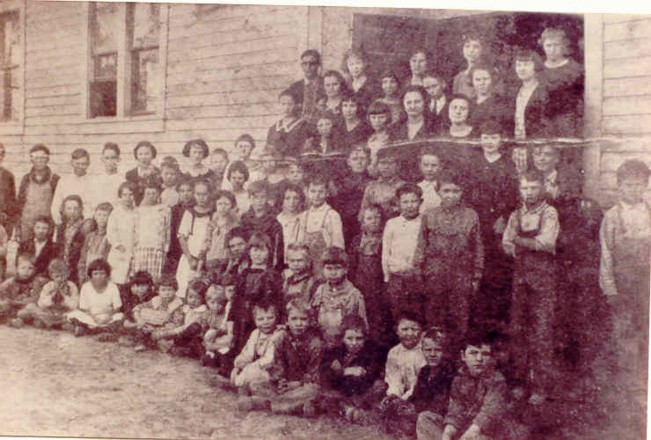
Gladys and Jack at the Smithville school. They are at the very
center; Jack is wearing overalls.
GLADYS: In 1929 I was thirteen and started to high school. It was also
the year the depression started. I do not recall that there was any
great change in our lifestyle. There had never been a lot of money at
our house. My parents owned their home. I’m sure they had many
worrisome hours about providing for the family, but we always ate and
had ample clothing. It was not until 1934 that I realized
the full meaning of hard times. I was 18, graduated from high school
and married two days after graduation to a boy in the local CCC camp.
Between us we had $12.50 and the license and minister’s fee cost
us five of that. He had only one month left in his camp time and
when that was done, we left by train for his home, Chelsea, Oklahoma.
His mother was a widow and he had two younger sisters at home. For a
few months we lived with them getting an odd job to earn money now and
then. After a year my husband became ill with tuberculosis. The doctor
told us it was worsened from breathing flour dust in the mill and that
he must find outside work to do. So we moved back to Smithville and my
folks. My father sometimes needed a man to go with him on his timber
estimates. I stayed with my mother while they were out on these trips
which sometimes took two or three days. That year we made a huge garden
and I canned over 500 jars of food to help stock the larder.
JACK: Pauline enjoyed tools and ordered the ones that appealed to
her. Sometimes the family worried she might harm herself using
them, and hid them from her. Pauline had a fear of lightening and
didn’t like trees to grow close to the house. One time she
decided to saw down a small tree that she considered would grow too
close to the house. She had sawed at least a third of the way
through the trunk before it was discovered. Reprimanded many
times by her adult children “to not overdo” she enjoyed the
smug satisfaction of her efforts. Pauline’s failing
health forced them to move to Mena, Arkansas in 1951 where medical help
was more available. ALICE: We moved from Smithville in 1953.

The modest but comfortable residence of Harry and Pauline on 7th Street
in Mena, Arkansas
Memories
DAVID: [Grandpa] made his way into my heart when he tagged the name
“Little Prime Minister” on me. He [another time] explained:
“After all, not everyone has been named after a
King.” [The first reference appears to be to David Lloyd
George, a British statesman; the second presumably to King David of the
Bible.] Then he got on all fours and crawled around the room
with me on his back. I was overjoyed. He was about 65 years of
age when I first remember him; but he was, and still is, tall and
straight, appearing to be much younger than his years. Even today, he
can quote verse from many famous works. He was a good scholar but
perhaps enjoyed mathematics, history and English the best of all
subjects. It was easy for him to make friends for he never knew a
stranger. He has a nervous habit of walking back and forth across the
room, head bowed and hands clasped behind his back. In retirement he
spends hours playing solitaire, wearing out decks of cards. He
follows all sports, but baseball is his favorite. He can recite
statistics of all the major ball teams. He has attended several World
Series games and can remember nearly every
play.
JERRY: I remember my grandfather as being very quiet, pretty withdrawn.
Was he? ALICE: He was reserved, but he could talk if you
asked him to. JS: Yeah, he could talk ... Usually he didn’t
pop off. What he had to say was really something to say.
JERRY: My grandparents were well up in the years when I
became old enough to remember much about them. Grandpa was tall, slim
and stood straight despite his age. His complexion was dark and one
might have guessed him to have Indian blood. He spent a lot of time
sitting in a rocking chair, listening to baseball games, smoking
hand-rolled cigarettes, putting the butts into an old roasting pan
filled with sand. His fingertips were stained by nicotine.
Grandma was short and quite plump. Her complexion was fair. In
old age she developed a marked dowager’s stoop. Her health
was poor and ... she had limited mobility. ... He dressed simply,
but my mother recalled he used to buy Kuppenheimer suits. There was a
time bankers and lawyers wore Kuppenheimer. ... Until the
early 50’s he still drove, and he liked to get in his old Ford
and “go to town” which in Smithville meant a couple stores,
the post office and a few houses. ....
JEAN: I remember Smithville as a sleepy little wide spot in the
road with the occasional pig crossing the road. Over the years we
traveled there to be nibbled on by ticks and mosquitoes and sat in the
hot church during long services. I fondly remember: Uncle Harry
bouncing a ball off of his head and singing ‘Frog Went
A’Courtin’; sitting next to Grandpa at the dining table and
watching his chin touch his nose with utter fascination; hiding
the little rubber snake in Grandpa’s bed and the resulting
hullaballoo; brushing and braiding Grandma’s long hair that she
tied at the end with hair from her brush; standing beside Grandpa as he
listened to ballgames and played solitaire at his roll-top desk;
playing with Grandma’s buttons (collected from worn-out clothing
and collected in a metal can over the years – better than
diamonds to a little girl.) And then there was riding down the
steep hill in Grandpa’s old car.
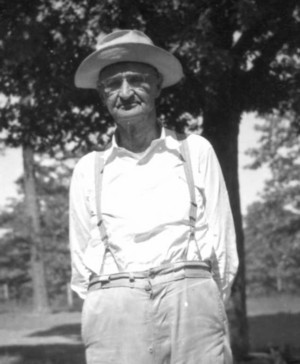
Harry in his "hiking and fishing" garb
Celebrating Pauline's 80th birthday: L
to R: Helen, Pauline, Jack, Alice, Harry Jr., Milam Wade, Gladys
LKS: In addition to the recollections present above, mention should be
made of Harry's attempt to become a published author. About 1953 he
finished a novel, "Fear Nothing", about a young man who comes to the
Indian Territory in the late 1800s to board with Choctaw families and
teach school. The title refers to the Indians' religious faith and code
of honor. Harry felt close to the Choctaws, learned some of their
language, and utilized his observations of Indian culture in writing
the book. The protaganist's supposed memoir is in a romantic and
moralistic style, familiar to Victorian readers but quite out of date
in our time. Primarily, however, it is a sympathetic description of a
culture and way of life that has virtually disappeared. Reportedly
Harry sent it to a woman in Tulsa who was to prepare a
professionally-typed manuscript and see to its publication. That did
not happen--indeed, the family thought the woman took advantage of
him--but
the original manuscript, typed laboriously on Harry's ancient
typewriter, survives. Images of the title page and a couple of pages of
texts, marked up with Harry's handwritten corrections and changes, can
be seen here.
* * *
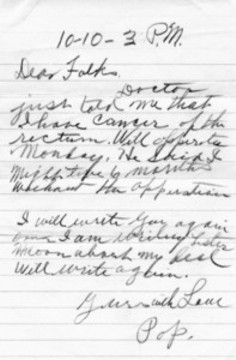 Harry died 21 December 1956 of colon cancer in the Veterans Hospital,
Little Rock, Arkansas.
Harry died 21 December 1956 of colon cancer in the Veterans Hospital,
Little Rock, Arkansas.
After spending a few years with her daughter,
Helen Wade, in Dallas, Pauline and daughter Alice Starr returned
to the Mena, Arkansas home. Pauline died there 29 January
1966.
Harry and Pauline are buried in the Starr plot at the Mena Cemetery
with four of their children and one son-in-law: William P., Helen Wade,
Alice Schisler and Gladys and Paul Campbell.
Harry and Pauline had eight children: Alice, William, Harry Jr., Estelle (died in infancy), Helen, Jack, Gladys and Ione.


 Although both grew up in middle class Georgia households, the early
years for Harry and Pauline couldn’t have been more diverse if
one designed them to be. Harry, reared by a single father, grew up in a
small rural Georgia community south of Atlanta. His father was a
medical doctor, but they likely lived on the profits from the small
general merchandise store he operated on the side. Understandably,
between two careers, Dr. John had little time for his growing son.
Harry’s Aunt Mary (Griffin) Tucker and her husband Thomas
welcomed Harry into their home at all hours of the day and night.
Although both grew up in middle class Georgia households, the early
years for Harry and Pauline couldn’t have been more diverse if
one designed them to be. Harry, reared by a single father, grew up in a
small rural Georgia community south of Atlanta. His father was a
medical doctor, but they likely lived on the profits from the small
general merchandise store he operated on the side. Understandably,
between two careers, Dr. John had little time for his growing son.
Harry’s Aunt Mary (Griffin) Tucker and her husband Thomas
welcomed Harry into their home at all hours of the day and night. The bustling city of Calhoun was a far cry from little Sunnyside.
Located on the direct railroad route between Atlanta and Chattanooga,
it was competing successfully with other communities for new industries
along that corridor. Pauline’s father purchased the nearest
boarding house/hotel to the train depot, giving Pauline opportunity to
meet travelers from all over. The trains took members of the
Rankin family back to South Carolina for semi-regular visits with
relatives. Thus during her early years Pauline was exposed to a far
wider world than was Harry. Moreover, Pauline’s father was a
well-known and respected local and state politician and had diverse
business interests. Little happened that escaped discussion
around their dinner table.
The bustling city of Calhoun was a far cry from little Sunnyside.
Located on the direct railroad route between Atlanta and Chattanooga,
it was competing successfully with other communities for new industries
along that corridor. Pauline’s father purchased the nearest
boarding house/hotel to the train depot, giving Pauline opportunity to
meet travelers from all over. The trains took members of the
Rankin family back to South Carolina for semi-regular visits with
relatives. Thus during her early years Pauline was exposed to a far
wider world than was Harry. Moreover, Pauline’s father was a
well-known and respected local and state politician and had diverse
business interests. Little happened that escaped discussion
around their dinner table.  Pauline was one of seven children. All received the best
education their father
could afford. The girls were brought up to be
“southern ladies.” This encompassed the arts of playing
a musical instrument, singing, giving recitations and conversing
with gentlemen. There would be others to do the drudgery of house
cleaning and laundry.
Pauline was one of seven children. All received the best
education their father
could afford. The girls were brought up to be
“southern ladies.” This encompassed the arts of playing
a musical instrument, singing, giving recitations and conversing
with gentlemen. There would be others to do the drudgery of house
cleaning and laundry.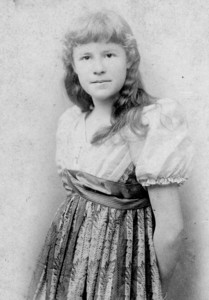
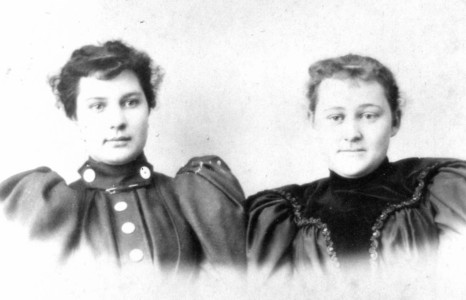
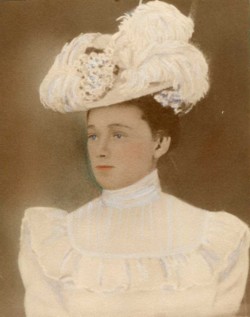
 “I enlisted at Austin Texas
on May 4th, 1898 in Co K of the
2nd Texas Vol. Inf. We
“I enlisted at Austin Texas
on May 4th, 1898 in Co K of the
2nd Texas Vol. Inf. We  were moved from there to Mobile Alabama thence
to Miami Fla. There in the month of July I was transferred to the
Hospital Corps. We were moved to Jacksonville Fla. and thence to
Savannah Ga. Here I was detached with two others for service in
Hospital Corps with Signal Corps. In December 1898 we were taken to
Havana Cuba and remained there until about May 1st, 1899. Then I was
transferred at my own request to the Hospital Ship Missouri. [Note: The
Missouri (the subject of the painting at right), one of America's
earliest hospital vessels, saw heroic service even before the war with
Spain. For an interesting account, go to this
site. The Missouri's
dramatic rescue in 1889 (before it became an American vessel) of the singking Danmark's passengers is depicted
here.] After
making a trip to Newport News, we went to Brooklyn N.Y. for repairs and
on Oct 16, 1899 we started to Manila P. I. and landed there about Dec
1st 1899. We left Manila P.I. about Jan 1st, 1900, and arrived in
San Francisco Calif in Feb 1900 where I remained on Duty until I was
discharged on May 4th 1900. I was given an honorable discharge by Major
A. C. Gerrard.” [file #1,490,903 Veterans
Administration]
were moved from there to Mobile Alabama thence
to Miami Fla. There in the month of July I was transferred to the
Hospital Corps. We were moved to Jacksonville Fla. and thence to
Savannah Ga. Here I was detached with two others for service in
Hospital Corps with Signal Corps. In December 1898 we were taken to
Havana Cuba and remained there until about May 1st, 1899. Then I was
transferred at my own request to the Hospital Ship Missouri. [Note: The
Missouri (the subject of the painting at right), one of America's
earliest hospital vessels, saw heroic service even before the war with
Spain. For an interesting account, go to this
site. The Missouri's
dramatic rescue in 1889 (before it became an American vessel) of the singking Danmark's passengers is depicted
here.] After
making a trip to Newport News, we went to Brooklyn N.Y. for repairs and
on Oct 16, 1899 we started to Manila P. I. and landed there about Dec
1st 1899. We left Manila P.I. about Jan 1st, 1900, and arrived in
San Francisco Calif in Feb 1900 where I remained on Duty until I was
discharged on May 4th 1900. I was given an honorable discharge by Major
A. C. Gerrard.” [file #1,490,903 Veterans
Administration]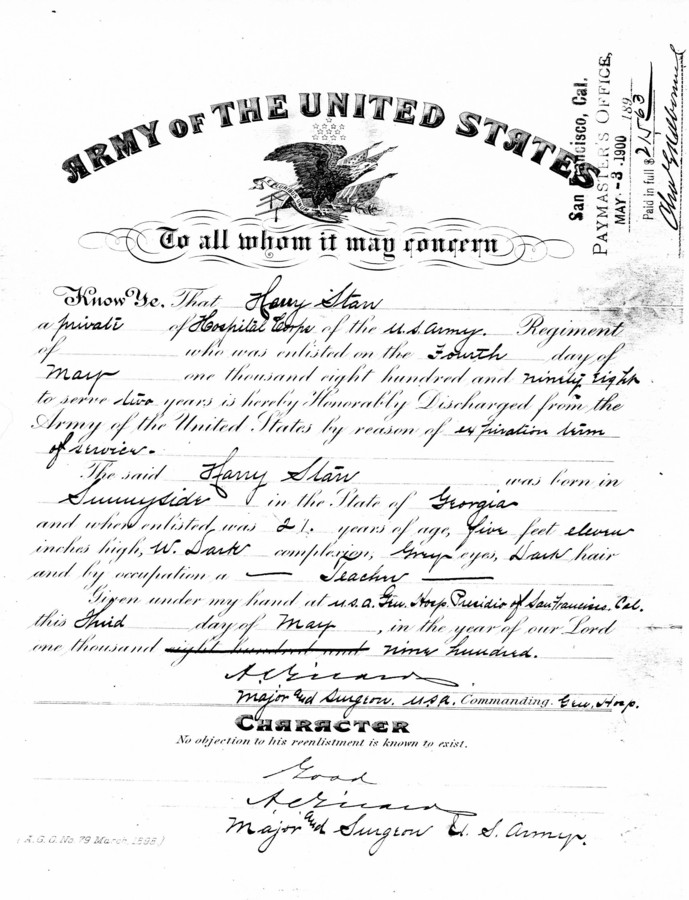
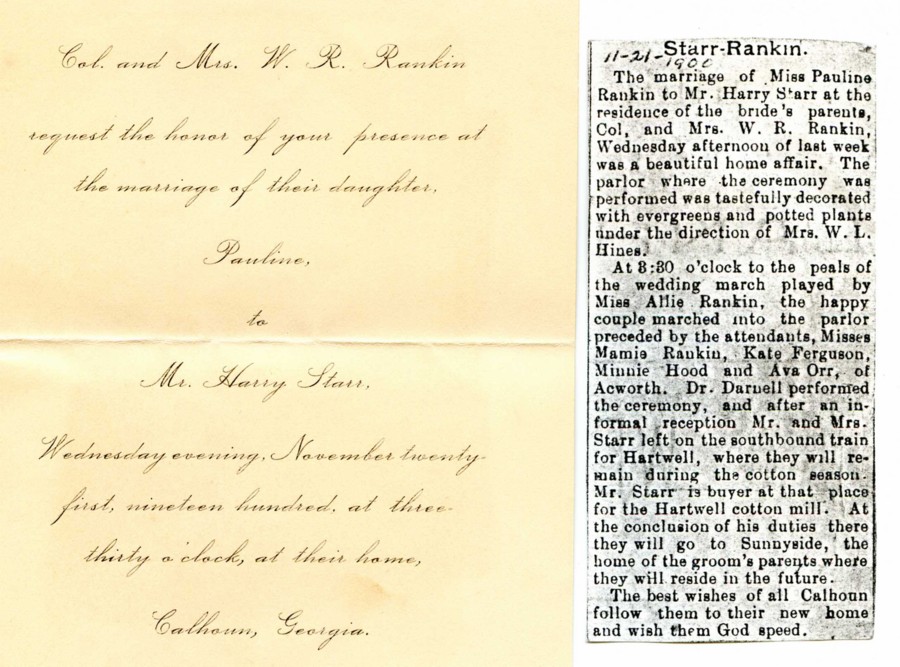
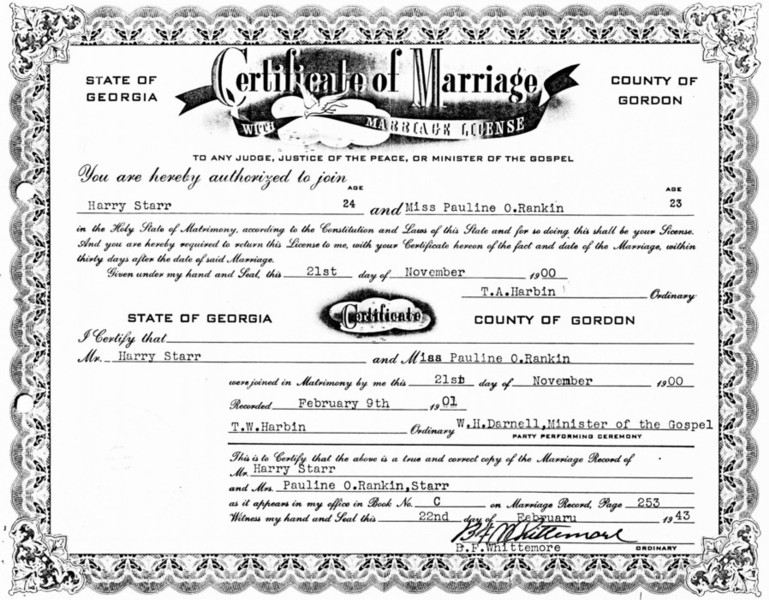
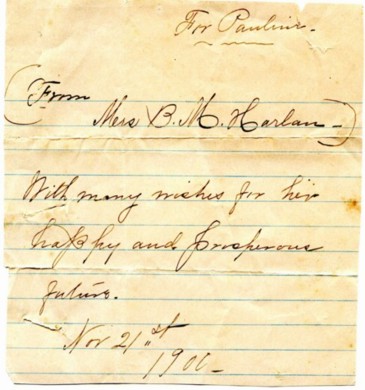



 was amazed that Pauline did not know to
“break” the water by adding a little lye. Pauline was
even more amazed when the lady offered to do the laundry for her. This
gesture shocked her. She had never heard of white folks hiring out to
do laundry. But she was delighted and Pauline became the first woman in
the camp to hire a laundress. I heard Mom tell this story many
times.
was amazed that Pauline did not know to
“break” the water by adding a little lye. Pauline was
even more amazed when the lady offered to do the laundry for her. This
gesture shocked her. She had never heard of white folks hiring out to
do laundry. But she was delighted and Pauline became the first woman in
the camp to hire a laundress. I heard Mom tell this story many
times.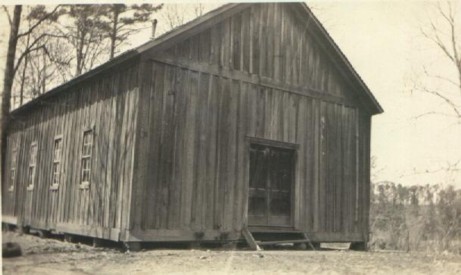
 DAVID: Some of his favorite stories are
about the schools in
southeastern OK. On the first day, he found himself the teacher with a
room full of one hundred children, seventy who could not speak a word
of English. His knowledge of the Indian language was sometimes
not enough, but this did not stump him. He just used
DAVID: Some of his favorite stories are
about the schools in
southeastern OK. On the first day, he found himself the teacher with a
room full of one hundred children, seventy who could not speak a word
of English. His knowledge of the Indian language was sometimes
not enough, but this did not stump him. He just used








 JACK: Democrat Woodrow Wilson was President when the family moved
to Smithville. Harry, a Democrat, was appointed Postmaster in 1916. He
ran a store in conjunction with the post office. With the election
of a Republican President in 1920, Harry lost his job as
postmaster. He then worked as an estimator and buyer of timber
for the Cove Lumber Company. In later years he did the same work
for the Three States Lumber Company. In 1929 he began working for
himself, surveying, estimating and purchasing timber. Harry loved
the outdoors and had a special love for trees.
JACK: Democrat Woodrow Wilson was President when the family moved
to Smithville. Harry, a Democrat, was appointed Postmaster in 1916. He
ran a store in conjunction with the post office. With the election
of a Republican President in 1920, Harry lost his job as
postmaster. He then worked as an estimator and buyer of timber
for the Cove Lumber Company. In later years he did the same work
for the Three States Lumber Company. In 1929 he began working for
himself, surveying, estimating and purchasing timber. Harry loved
the outdoors and had a special love for trees. 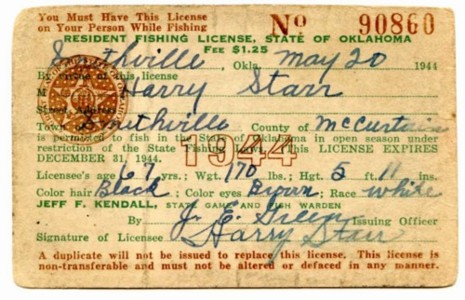
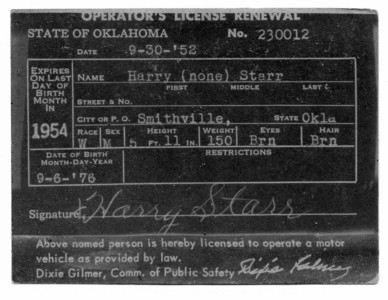



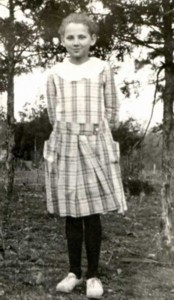
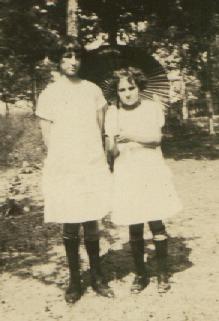


 JERRY: A lady at work was
remembering the hand dug well of her
childhood; she mentioned frogs. JACK: In the
early days, before we had a wood curb on the well, it was impossible to
keep frogs out. It’s a kind of a wood box around the well.
You’d get some frogs in there in spite of an anything you’d
do, especially in the dry periods of the summer when there wasn’t
any water anywhere else. You could see them down there, swimming
around. You could usually get them out by just letting the bucket down
and holding it over near the frog. It’d go into the bucket and
you could pull it out. But about once a year we’d clean out
the well because there was always dirt and stuff that would fall off
the side of the dug well. It was my job to go down in there. I’d
sit on the bucket and they’d let me down into the well which was
about 30 feet deep.
JERRY: A lady at work was
remembering the hand dug well of her
childhood; she mentioned frogs. JACK: In the
early days, before we had a wood curb on the well, it was impossible to
keep frogs out. It’s a kind of a wood box around the well.
You’d get some frogs in there in spite of an anything you’d
do, especially in the dry periods of the summer when there wasn’t
any water anywhere else. You could see them down there, swimming
around. You could usually get them out by just letting the bucket down
and holding it over near the frog. It’d go into the bucket and
you could pull it out. But about once a year we’d clean out
the well because there was always dirt and stuff that would fall off
the side of the dug well. It was my job to go down in there. I’d
sit on the bucket and they’d let me down into the well which was
about 30 feet deep. 


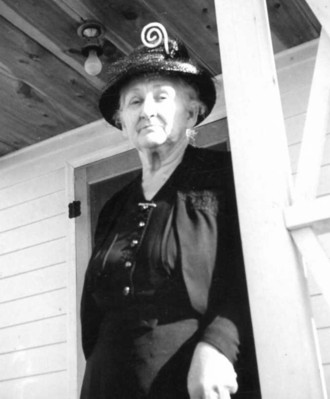
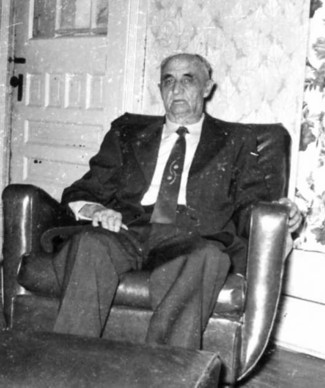
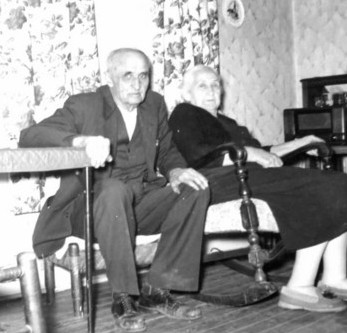

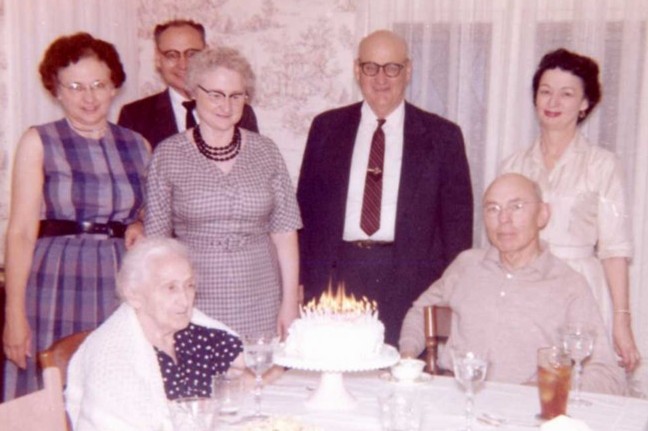
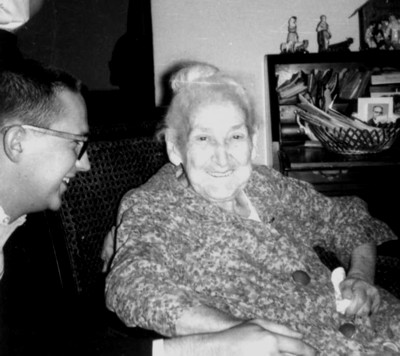
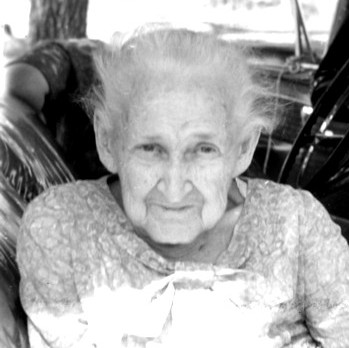
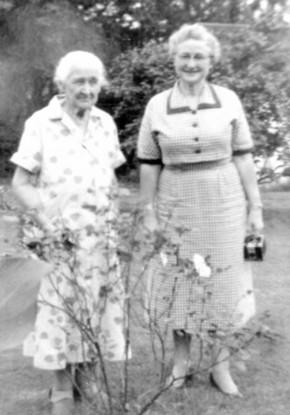
 Harry died 21 December 1956 of colon cancer in the Veterans Hospital,
Little Rock, Arkansas.
Harry died 21 December 1956 of colon cancer in the Veterans Hospital,
Little Rock, Arkansas.